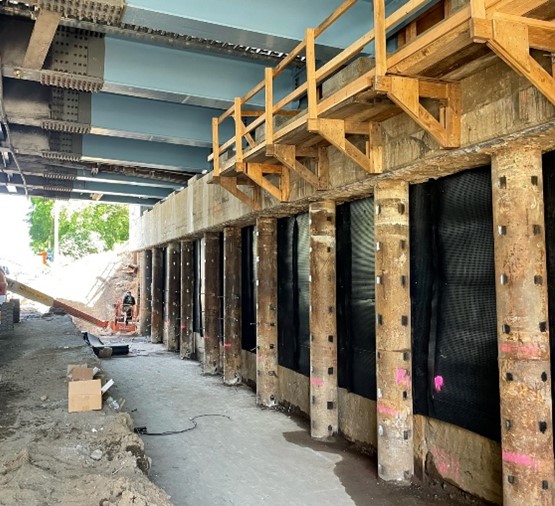Van Wyck Expressway Capacity & Access Improvements to JFK Airport
Location:
Queens, NY
Client:
NYSDOT
Contract Value:
$326.7 Million
Project Dates:
July 2020 – November 2023
• Asphalt Milling & Reclamation
• Asphalt Paving
• Bridgeworks
• Civil Highway & Ramp Rehabilitation
• Electrical Infrastructure
• Excavation/SOE/Foundation
• Full Depth Road Restoration
• Micro Piles
• Rock Anchors
• Signage & Pavement Markings
• Sitework & Restoration
• Steel Erection
• Tiebacks
• Utility & Drainage Installation
PROJECT OVERVIEW
This $327M project is phase one of three projects to increase capacity on the VWE between the Kew Gardens Interchange and John F. Kennedy International Airport to improve access to and from the airport. Additionally, it resolves deficient ramp geometries and structural deficiencies of bridges. The VWE provides passenger and commercial truck access routes to the airport. Nine overpass bridges were reconstructed and lengthened to allow for the future widening of the VWE. Four of the nine bridges have been completely replaced; five were lengthened and underwent deck replacements. Complex staging allowed the bridges to remain operational throughout construction. Two new highway ramps were also constructed to replace existing ramps with deficient safety features. One ramp connects North Conduit Ave to the WB Belt parkway and the second ramp lengthens the merge area from the NB VWE to the NB VWE Service Road.
WHAT MADE THIS JOB COMPLEX
Working in a dense urban area while maintaining traffic on the structures during high peak travel times was a challenge. The nine bridges to be lengthened were already choked by the crossing service roads which left little to no space for approach work zones. Existing utilities such as gas mains, water mains, electric, telephone, cable TV services, FDNY communication and Intelligent Transportation Systems (ITS) crossed all the bridges and meandered in all directions behind the abutments. Every utility had to be “straightened” out to be carried by the longer girders and this involved trenching through the intersections and as much as a city block away to avoid interferences and to upgrade the facilities to modern standards. Aging water mains and valves from the 1800’s had to be modernized well beyond the project limits to tie in the new water mains. The new abutments were constructed using top down methods which allowed the excavations to be bridged up to 37 LF to allow peak traffic.
HOW POSILLICO SOLVED IT
Posillico formed a Joint Venture with El Sol Contracting, and used top down construction methods to create the new Abutment while maintaining traffic. A sheeted trench was excavated across the entire roadway behind the existing abutments. Temporary bridge panels were fabricated from steel reinforced timber mats and steel road plates welded to wide flange sections to bridge the gap from existing abutment to the approach behind the new abutment. In off-hour lane closures, the temp bridges could be removed to drill micropiles across the trench that would form the new abutment. Once piles were tested and accepted, an abutment concrete cap was formed and placed with sleeves to allow tieback to be drilled through the cap. When the tiebacks were tested and complete, the pockets were closed with concrete, and the volume of earth between the new and old abutments was excavated below the grade of the Van Wyck Expressway. Studs were welded to the micropile cans and reinforcement was installed to create a wall under the concrete cap to encapsulate the piles and form a stem for the abutment. Once the new bridges were installed on the new abutment, the existing abutments were demolished to permit future widening of the expressway. This form of construction permitted continued full use of the structures in peak hours.






